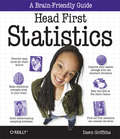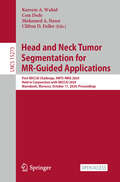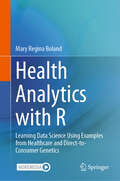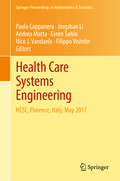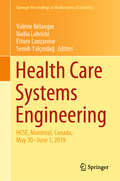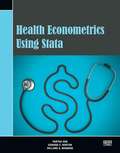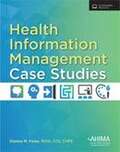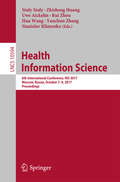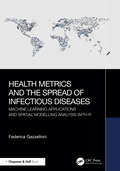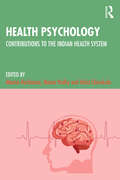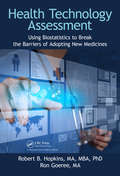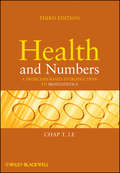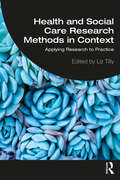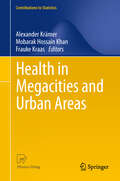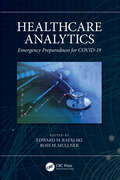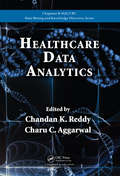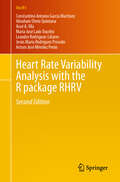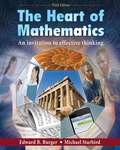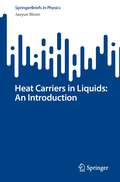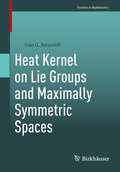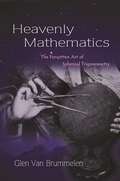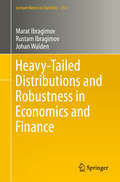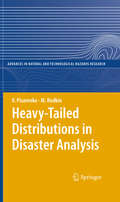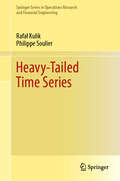- Table View
- List View
Head First Statistics: A Brain-Friendly Guide (Head First)
by Dawn GriffithsWouldn't it be great if there were a statistics book that made histograms, probability distributions, and chi square analysis more enjoyable than going to the dentist? Head First Statistics brings this typically dry subject to life, teaching you everything you want and need to know about statistics through engaging, interactive, and thought-provoking material, full of puzzles, stories, quizzes, visual aids, and real-world examples.Whether you're a student, a professional, or just curious about statistical analysis, Head First's brain-friendly formula helps you get a firm grasp of statistics so you can understand key points and actually use them. Learn to present data visually with charts and plots; discover the difference between taking the average with mean, median, and mode, and why it's important; learn how to calculate probability and expectation; and much more.Head First Statistics is ideal for high school and college students taking statistics and satisfies the requirements for passing the College Board's Advanced Placement (AP) Statistics Exam. With this book, you'll:Study the full range of topics covered in first-year statisticsTackle tough statistical concepts using Head First's dynamic, visually rich format proven to stimulate learning and help you retain knowledge Explore real-world scenarios, ranging from casino gambling to prescription drug testing, to bring statistical principles to lifeDiscover how to measure spread, calculate odds through probability, and understand the normal, binomial, geometric, and Poisson distributionsConduct sampling, use correlation and regression, do hypothesis testing, perform chi square analysis, and moreBefore you know it, you'll not only have mastered statistics, you'll also see how they work in the real world. Head First Statistics will help you pass your statistics course, and give you a firm understanding of the subject so you can apply the knowledge throughout your life.
Head and Neck Tumor Segmentation for MR-Guided Applications: First MICCAI Challenge, HNTS-MRG 2024, Held in Conjunction with MICCAI 2024, Marrakesh, Morocco, October 17, 2024, Proceedings (Lecture Notes in Computer Science #15273)
by Kareem A. Wahid Cem Dede Mohamed A. Naser Clifton D. FullerThis Open Access book constitutes the refereed proceedings of the First MICCAI Challenge, HNTSMRG 2024, Held in Conjunction with MICCAI 2024, in Marrakesh, Morocco, on October 17, 2024. The 20 full papers and 1 overview paper included in this volume were carefully reviewed and selected from a total of 21 submissions. The HNTS-MRG 2024 Challenge focuses on advancing clinical workflows by leveraging artificial intelligence (AI) for automated segmentation of tumor regions in multi-timepoint MRI scans.
Health Analytics with R: Learning Data Science Using Examples from Healthcare and Direct-to-Consumer Genetics
by Mary Regina BolandThis textbook teaches health analytics using examples from the statistical programming language R. It utilizes real-world examples with publicly available datasets from healthcare and direct-to-consumer genetics to provide learners with real-world examples and enable them to get their hands on actual data. This textbook is designed to accompany either a senior-level undergraduate course or a Masters level graduate course on health analytics. The reader will advance from no prior knowledge of R to being well versed in applications within R that apply to data science and health analytics. “I have never seen a book like this and think it will make an important contribution to the field. I really like that it covers environmental, social, and geospatial data. I also really like the coverage of ethics. These aspects of health analytics are often overlooked or deemphasized. I will definitely buy copies for my team.” - Jason Moore, Cedars-Sinai Medical Center “Overall, I have a highly positive impression of the book. It is VERY comprehensive. It covers very extensive data types. I do not recall other books with the same level of comprehensiveness.” - Shuangge Ma, Yale University “The book is comprehensive in both aspects of genetics, and health analytics. It covers any type of information a healthcare data scientist should be familiar with, whether they are novice or experienced. I found any chapter that I looked into comprehensive, but also not too detailed (although in general this book is more than 600 pages of comprehensive and detailed relevant information).” - Robert Moskovtich, Ben-Gurion University of the Negev
Health Care Systems Engineering
by Jingshan Li Andrea Matta Evren Sahin Nico J. Vandaele Paola Cappanera Filippo VisintinThis book presents statistical processes for health care delivery and covers new ideas, methods and technologies used to improve health care organizations. It gathers the proceedings of the Third International Conference on Health Care Systems Engineering (HCSE 2017), which took place in Florence, Italy from May 29 to 31, 2017. The Conference provided a timely opportunity to address operations research and operations management issues in health care delivery systems. Scientists and practitioners discussed new ideas, methods and technologies for improving the operations of health care systems, developed in close collaborations with clinicians. The topics cover a broad spectrum of concrete problems that pose challenges for researchers and practitioners alike: hospital drug logistics, operating theatre management, home care services, modeling, simulation, process mining and data mining in patient care and health care organizations.
Health Care Systems Engineering: HCSE, Montréal, Canada, May 30 - June 1, 2019 (Springer Proceedings in Mathematics & Statistics #316)
by Ettore Lanzarone Valérie Bélanger Nadia Lahrichi Semih YalçındağThis book presents the proceedings of the Fourth International Conference on Health Care Systems Engineering (HCSE 2019), which took place in Montreal, Canada, from May 30 to June 1, 2019. The event took place in the mother and child university hospital CHU Sainte-Justine in Montréal, and each session was co-chaired by a discussant coming from the clinical practice.The conference offered scientists and practitioners an opportunity to discuss operations management issues in health care delivery systems, and to share new ideas, methods and technologies for improving the operation of health care organizations.Focusing on applications of systems engineering, optimization and statistics to improve health care delivery and health systems, the book covers topics relating to a broad spectrum of concrete problems that pose challenges for researchers and practitioners alike, including hospital drug logistics, operating theatre management, blood donation, home care services, modeling, simulation, process mining and data mining in patient care and health care organizations.
Health Econometrics Using Stata
by Partha Deb Edward Norton Willard ManningHealth Econometrics Using Stataby Partha Deb, Edward C. Norton, and Willard G. Manning provides an excellent overview of the methods used to analyze data on healthcare expenditure and use. Aimed at researchers, graduate students, and practitioners, this book introduces readers to widely used methods, shows them how to perform these methods in Stata, and illustrates how to interpret the results. Each method is discussed in the context of an example using an extract from the Medical Expenditure Panel Survey. After the overview chapters, the book provides excellent introductions to a series of topics aimed specifically at those analyzing healthcare expenditure and use data. The basic topics of linear regression, the generalized linear model, and log and Box-Cox models are covered with a tight focus on the problems presented by these data. Using this foundation, the authors cover the more advanced topics of models for continuous outcome with mass points, count models, and models for heterogeneous effects. Finally, they discuss endogeneity and how to address inference questions using data from complex surveys. The authors use their formidable experience to guide readers toward useful methods and away from less recommended ones. Their discussion of "health econometric myths" and the chapter presenting a framework for approaching health econometric estimation problems are especially useful for this aspect. , count models, and models for heterogeneous effects. Finally, they discuss endogeneity and how to address inference questions using data from complex surveys. The authors use their formidable experience to guide readers toward useful methods and away from less recommended ones. Their discussion of "health econometric myths" and the chapter presenting a framework for approaching health econometric estimation problems are especially useful for this aspect.
Health Information Management Case Studies
by Dianna M. FoleyThe contents of the Health Information Management Case Studies include: Domain I Data Content, Structure, and Standards (Information Governance); Domain II Information Protection: Access, Disclosure, Archival, Privacy and Security; Domain III--Informatics, Analytics, and Data Use; Domain IV--Revenue Management;Domain V--Compliance; and Domain VI--Leadership.
Health Information Science: 6th International Conference, HIS 2017, Moscow, Russia, October 7-9, 2017, Proceedings (Lecture Notes in Computer Science #10594)
by Siuly Siuly, Zhisheng Huang, Uwe Aickelin, Rui Zhou, Hua Wang, Yanchun Zhang and Stanislav KlimenkoThis book constitutes the refereed proceedings of the 6th International Conference on Health Information Science, HIS 2017, held in Moscow, Russia, in October 2017.The 11 full papers and 7 short papers presented were carefully reviewed and selected from 44 submissions. The papers feature multidisciplinary research results in health information science and systems that support health information management and health service delivery. They relate to all aspects of the conference scope, such as medical/health/biomedicine information resources such as patient medical records, devices and equipments, software and tools to capture, store, retrieve, process, analyze, and optimize the use of information in the health domain; data management, data mining, and knowledge discovery, management of publichealth, examination of standards, privacy and security issues; computer visualization and artificial intelligence for computer aided diagnosis; development of new architectures and applications for health information systems.
Health Metrics and the Spread of Infectious Diseases: Machine Learning Applications and Spatial Modelling Analysis with R
by Federica GazzelloniHealth Metrics and the Spread of Infectious Diseases: Machine Learning Applications and Spatial Modelling Analysis with R is an introductory guide to health metrics and infectious diseases. It demonstrates how to calculate these metrics to compare the health status of different countries and explores the world of infectious diseases. It tests various machine learning tools for analyzing trends and relationships among key variables, aiming to prevent unexpected outcomes. Through detailed explanations and practical examples, readers will gain a comprehensive understanding of Disability Adjusted Life Years (DALYs) and their components.Key Features: Structured into four main sections—foundational health metrics, machine learning applications, data visualization, and real-world case studies Integrates real-world case studies with data visualization and machine learning techniques, including spatial modelling with the R programming language Covers specific infectious diseases such as COVID-19 and malaria, providing insights into their spread and control Includes detailed explanations, practical exercises, and clear illustrations to enhance understanding and application Adopts a practical approach, making advanced concepts accessible to a wide audience The book is primarily aimed at researchers, data scientists, and public health professionals who seek to leverage data to improve health outcomes. By blending theoretical knowledge with practical applications, the book equips readers with the tools to make informed decisions and produce meaningful data analyses in public health.
Health Psychology: Contributions to the Indian Health System
by Meena Hariharan Meera Padhy Usha ChivukulaThis book provides a holistic understanding of the state of health psychology in the Indian context and the types of psychological and social support and welfare that are offered and required within treatment processes for various illnesses. The book discusses why health care should be the prerogative of both the biomedical profession and health psychologists and how they work together with medical professionals to augment public health. It emphasises the shift from biomedical to biopsychosocial approach in strengthening health care outcomes. The book highlights the substantial contribution of health psychology to the Indian health care system through simple, cost-effective, indigenous, and standardised techniques that worked efficiently in the context of various diseases. It projects the emerging trends and innovative techniques in health psychology in handling challenging health care needs. This book will be of interest to students, teachers, and researchers of psychology, psychiatry, social psychology, sociology, social work and South Asian studies.
Health Technology Assessment: Using Biostatistics to Break the Barriers of Adopting New Medicines
by Robert B. Hopkins MA MBA PhD Ron Goeree MAThe term health technology refers to drugs, devices, and programs that can improve and extend quality of life. As decision-makers struggle to find ways to reduce costs while improving health care delivery, health technology assessments (HTA) provide the evidence required to make better-informed decisions.This is the first book that focuses on the s
Health and Care in Old Age in Africa (Routledge Contemporary Africa)
by Pranitha MaharajThis book explores health and care of the older population in Africa, focusing on policy and programmatic responses, gaps and future challenges related to health and care across the continent. The first part of the book sets the scene for the volume, profiling the demographic and health situation of the elderly in Africa. It also provides an overview of the various models of care in Africa, looking in particular at the family care model, which constitutes the main source of support for the elderly in Africa. Part 2 provides case studies from across the continent to explore varying forms of elder care as well as the health challenges facing the elderly in the different contexts. The final part considers key aspects related to older person’s experience of social pensions, which are widely recognised as a potentially powerful strategy of meeting the needs of older persons.. Identifying lessons regarding African-centric models of care, as well as reflections on the structural and policy challenges that are likely to confront countries across the continent as they strive to meet the specific needs of increasingly ageing populations, this book will be of interest to scholars of health and social care of the elderly.
Health and Numbers
by Chap T. LeLike its two successful previous editions, Health & Numbers: A Problems-Based Introduction to Biostatistics, Third Edition, is the only fully problems-based introduction to biostatistics and offers a concise introduction to basic statistical concepts and reasoning at a level suitable for a broad spectrum of students and professionals in medicine and the allied health fields. This book has always been meant for use by advanced students who have not previously had an introductory biostatistics course - material often presented in a one-semester course - or by busy professionals who need to learn the basics of biostatistics. This user-friendly resource features over 200 real-life examples and real data to discuss and teach fundamental statistical methods. The new edition offers even more exercises than the second edition, and features enhanced Microsoft Excel and SAS samples and examples. Health & Numbers, Third Edition, truly strikes a balance between principles and methods of calculation that is particularly useful for students in medicine and health-related fields who need to know biostatistics.
Health and Social Care Research Methods in Context: Applying Research to Practice
by Liz TillyThis is the first textbook to show how research using a range of qualitative and quantitative methods relates to improving health and social care practice. The book shows how different research approaches are undertaken in practice and the challenges and strengths of different methodologies, thus facilitating students to make informed decisions when choosing which to use in their own research projects. The eleven chapters are each structured around different research methods and include: A brief overview of the research and research question Identification and overview of the research approach and associated methods selected to answer this question The sample and recruitment, including issues and challenges Ethical concerns Practical issues in undertaking the research approach Links between the research process and findings to health and social care values Links to the full research study Further reading The book will be a required reading for all students of social work; social care; nursing; public health and health studies and particularly suitable for those on widening participation courses.
Health in Megacities and Urban Areas
by Alexander Krämer Mobarak Hossain Khan Frauke KraasDiverse driving forces, processes and actors are responsible for different trends in the development of megacities and large urban areas. Under the dynamics of global change, megacities are themselves changing: On the one hand they are prone to increasing socio-economic vulnerability due to pronounced poverty, socio-spatial and political fragmentation, sometimes with extreme forms of segregation, disparities and conflicts. On the other hand megacities offer positive potential for global transformation, e.g. minimisation of space consumption, highly effective use of resources, efficient disaster prevention and health care options - if good strategies were developed. At present in many megacities and urban areas of the developing world and the emerging economies the quality of life is eroding. Most of the megacities have grown to unprecedented size, and the pace of urbanisation has far exceeded the growth of the necessary infrastructure and services. As a result, an increasing number of urban dwellers are left without access to basic amenities like clean drinking water, fresh air and safe food. Additionally, social inequalities lead to subsequent and significant intra-urban health inequalities and unbalanced disease burdens that can trigger conflict and violence between subpopulations. The guiding idea of our book lies in a multi- and interdisciplinary approach to the complex topic of megacities and urban health that can only be adequately understood when different disciplines share their knowledge and methodological tools to work together. We hope that the book will allow readers to deepen their understanding of the complex dynamics of urban and megacity populations through the lens of public health, geographical and other research perspectives.
Healthcare Analytics: Emergency Preparedness for COVID-19
by Ross M. Mullner Edward M. RafalskiThe first COVID-19 case in the US was reported on January 20, 2020. As the first cases were being reported in the US, Washington State became a reliable source not just for hospital bed demand based on incidence and community spread but also for modeling the impact of skilled nursing facilities and assisted living facilities on hospital bed demand. Various hospital bed demand modeling efforts began in earnest across the United States in university settings, private consulting and health systems. Nationally, the University of Washington Institute of Health Metrics and Evaluation seemed to gain a footing and was adopted as a source for many states for its ability to predict the epidemiological curve by state, including the peak. This book therefore addresses a compelling need for documenting what has been learned by the academic and professional healthcare communities in healthcare analytics and disaster preparedness to this point in the pandemic. What is clear, at least from the US perspective, is that the healthcare system was unprepared and uncoordinated from an analytics perspective. Learning from this experience will only better prepare all healthcare systems and leaders for future crisis. Both prospectively, from a modeling perspective and retrospectively from a root cause analysis perspective, analytics provide clarity and help explain causation and data relationships. A more structured approach to teaching healthcare analytics to students, using the pandemic and the rich dataset that has been developed, provides a ready-made case study from which to learn and inform disaster planning and preparedness. The pandemic has strained the healthcare and public health systems. Researchers and practitioners must learn from this crisis to better prepare our processes for future pandemics, at minimum. Finally, government officials and policy makers can use this data to decide how best to assist the healthcare and public health systems in crisis.
Healthcare Data Analytics (Chapman & Hall/CRC Data Mining and Knowledge Discovery Series)
by Charu C. Aggarwal Chandan K. ReddyAt the intersection of computer science and healthcare, data analytics has emerged as a promising tool for solving problems across many healthcare-related disciplines. Supplying a comprehensive overview of recent healthcare analytics research, Healthcare Data Analytics provides a clear understanding of the analytical techniques currently available
Heart Rate Variability Analysis with the R package RHRV (Use R!)
by Xosé A. Vila Leandro Rodríguez-Liñares Constantino Antonio García Martínez Abraham Otero Quintana María José Lado Touriño Jesús María Rodríguez Presedo Arturo José Méndez PenínThis book introduces readers to the fundamental concepts of Heart Rate Variability (HRV) and its most important analysis algorithms using a hands-on approach based on the open-source RHRV software. HRV refers to the variation over time of the intervals between consecutive heartbeats. Despite its apparent simplicity, HRV is one of the most important markers of autonomic nervous system activity and it has been recognized as a useful predictor of several pathologies. The book discusses all the basic HRV topics, including the physiological contributions to HRV, clinical applications, HRV data acquisition, HRV data manipulation and HRV analysis using time-domain, frequency-domain, time-frequency, nonlinear and fractal techniques. Detailed examples based on real data sets are provided throughout the book to illustrate the algorithms and discuss the physiological implications of the results. Offering a comprehensive guide to analyzing beat information with RHRV, the book is intended for masters and Ph.D. students in various disciplines such as biomedical engineering, human and veterinary medicine, biology, and pharmacy, as well as researchers conducting heart rate variability analyses on both human and animal data. The second edition of the book has been updated to RHRV version 5.0. This version introduces a functionality to perform heart rate variability analysis on entire populations. This functionality automates and streamlines both the calculation of HRV indices in the time, frequency, and nonlinear domains, as well as the subsequent statistical analysis.
Heart of Mathematics: An Invitation to Effective Thinking (Third Edition)
by Edward B. Burger Michael StarbirdMake mathematics fun and satisfying for everyone Math can be a living source of powerful ideas that transcend mathematics; a window into mind-opening philosophical concepts such as infinity, fourth dimensions, chaos, and fractals; and a practical training ground for developing skills in analysis, reasoning, and thought if you have the right approach and the right guide. The Heart of Mathematics: An Invitation to Effective Thinking, now in its third edition, transforms mathematics into an engaging, relevant experience even for the most math-phobic student. Infusing this book with humor and enthusiasm, Edward B. Burger and Michael Starbird both recipients of the Mathematical Association of America's foremost national teaching award and countless state, regional, and campus-wide teaching honors introduce students to the most important and interesting ideas in mathematics while inspiring them to actively engage in mathematical thinking. Richer and more rewarding than ever, this new edition features: An emphasis on mathematical methods of investigation Visualization techniques that make key concepts easier to understand Accessible, friendly writing style that encourages critical thinking "Life Lessons"-effective methods of thinking that students will retain and apply beyond the classroom End of section Mindscape activities for the development of application, problem-solving, and argumentation skills.
Heat Carriers in Liquids: An Introduction (SpringerBriefs in Physics)
by Jaeyun MoonThis book provides a succinct overview of recent progress in characterization of heat carriers describing atomic motion in liquids. Unlike solids and gases where heat carriers are typically described by phonons and real atomic particles, the nature of effective heat carriers in liquids is still elusive. The emphasis is on two widely used spectral methods to describe heat carriers: instantaneous normal modes and velocity autocorrelation functions. Various bulk materials properties from a bottom-up perspective using these spectra are presented in detail. This book is an ideal introduction to the field for graduate students and young researchers.
Heat Kernel on Lie Groups and Maximally Symmetric Spaces (Frontiers in Mathematics)
by Ivan G. AvramidiThis monograph studies the heat kernel for the spin-tensor Laplacians on Lie groups and maximally symmetric spaces. It introduces many original ideas, methods, and tools developed by the author and provides a list of all known exact results in explicit form – and derives them – for the heat kernel on spheres and hyperbolic spaces. Part I considers the geometry of simple Lie groups and maximally symmetric spaces in detail, and Part II discusses the calculation of the heat kernel for scalar, spinor, and generic Laplacians on spheres and hyperbolic spaces in various dimensions. This text will be a valuable resource for researchers and graduate students working in various areas of mathematics – such as global analysis, spectral geometry, stochastic processes, and financial mathematics – as well in areas of mathematical and theoretical physics – including quantum field theory, quantum gravity, string theory, and statistical physics.
Heavenly Mathematics: The Forgotten Art of Spherical Trigonometry
by Glen Van BrummelenAn unparalleled illustrated history of spherical trigonometry from antiquity to todayHeavenly Mathematics traces the rich history of spherical trigonometry, revealing how the cultures of classical Greece, medieval Islam, and the modern West used this forgotten art to chart the heavens and the Earth. Once at the heart of astronomy and ocean-going navigation for two millennia, the discipline was also a mainstay of mathematics education for centuries and taught widely until the 1950s. Glen Van Brummelen explores this exquisite branch of mathematics and its role in ancient astronomy, geography, and cartography; Islamic religious rituals; celestial navigation; polyhedra; stereographic projection; and more. He conveys the sheer beauty of spherical trigonometry, providing readers with a new appreciation of its elegant proofs and often surprising conclusions. Heavenly Mathematics is illustrated throughout with stunning historical images and informative drawings and diagrams. This unique compendium also features easy-to-use appendixes as well as exercises that originally appeared in textbooks from the eighteenth to the early twentieth centuries.
Heavy-Tailed Distributions and Robustness in Economics and Finance
by Marat Ibragimov Rustam Ibragimov Johan WaldenThis book focuses on general frameworks for modeling heavy-tailed distributions in economics, finance, econometrics, statistics, risk management and insurance. A central theme is that of (non-)robustness, i. e. , the fact that the presence of heavy tails can either reinforce or reverse the implications of a number of models in these fields, depending on the degree of heavy-tailed ness. These results motivate the development and applications of robust inference approaches under heavy tails, heterogeneity and dependence in observations. Several recently developed robust inference approaches are discussed and illustrated, together with applications.
Heavy-Tailed Distributions in Disaster Analysis
by M. Rodkin V. PisarenkoMathematically, natural disasters of all types are characterized by heavy tailed distributions. The analysis of such distributions with common methods, such as averages and dispersions, can therefore lead to erroneous conclusions. The statistical methods described in this book avoid such pitfalls. Seismic disasters are studied, primarily thanks to the availability of an ample statistical database. New approaches are presented to seismic risk estimation and forecasting the damage caused by earthquakes, ranging from typical, moderate events to very rare, extreme disasters. Analysis of these latter events is based on the limit theorems of probability and the duality of the generalized Pareto distribution and generalized extreme value distribution. It is shown that the parameter most widely used to estimate seismic risk - Mmax, the maximum possible earthquake value - is potentially non-robust. Robust analogues of this parameter are suggested and calculated for some seismic catalogues. Trends in the costs inferred by damage from natural disasters as related to changing social and economic situations are examined for different regions. The results obtained argue for sustainable development, whereas entirely different, incorrect conclusions can be drawn if the specific properties of the heavy-tailed distribution and change in completeness of data on natural hazards are neglected. This pioneering work is directed at risk assessment specialists in general, seismologists, administrators and all those interested in natural disasters and their impact on society.
Heavy-Tailed Time Series (Springer Series in Operations Research and Financial Engineering)
by Rafal Kulik Philippe SoulierThis book aims to present a comprehensive, self-contained, and concise overview of extreme value theory for time series, incorporating the latest research trends alongside classical methodology. Appropriate for graduate coursework or professional reference, the book requires a background in extreme value theory for i.i.d. data and basics of time series. Following a brief review of foundational concepts, it progresses linearly through topics in limit theorems and time series models while including historical insights at each chapter’s conclusion. Additionally, the book incorporates complete proofs and exercises with solutions as well as substantive reference lists and appendices, featuring a novel commentary on the theory of vague convergence.
